
Introduction
There's been a big influx of new gaming screens to
the market over the last couple of years, with significant improvements coming
in the form of 2560 x 1440 resolution TN Film panels, dynamic refresh rate
technologies like
NVIDIA G-sync and AMD FreeSync, and various
blur reducing backlight techniques. All in the name of providing excellent
LCD gaming experience. Previously fairly small players in the monitor market
like Asus and Acer have emerged from the pack with exciting high end gaming
specs and features attracting new buyers all the time.
Some mainstream and well-established manufacturers
like Dell have generally stayed away from this fairly niche gaming market, in
favour of producing a solid line-up of more general office and multimedia-type
displays. A couple of years ago Dell pushed in to the more professional market
with their high end UltraSharp range and they've invested more recently in UltraHD, 4K and 5k resolutions for their UltraSharp Premium (UP) range for very
high end systems. Until now, Dell have still stayed away form the gaming market
but that has just changed. They have just released their new S2716DG display, a
model specifically aimed at gamers. It features a 2560 x 1440 resolution 27"
panel based on TN Film technology, with a low 1ms G2G response time, 144Hz
native refresh rate, G-sync support and even an ULMB (Ultra Low Motion Blur) mode.
These are the kind of features being offered on high end gaming screens from the
likes of Asus (ROG
Swift PG278Q) and Acer (XG270HU)
but this time under the popular Dell brand. This also goes hand in hand with
their long-established support and warranty service which will help to attract
new buyers for sure.
If you appreciate the review
and enjoy reading and like our work, we would welcome a
donation
to the site to help us continue to make quality and detailed reviews for you.
|
Check Pricing and Buy - Direct Links
|
|
Amazon USA |
Amazon
UK |
Amazon GER |
Amazon CAN
|
|
TFTCentral is a participant
in the Amazon Services LLC Associates Programme, an affiliate
advertising programme designed to provide a means for sites to earn
advertising fees by advertising and linking to Amazon.com, Amazon.co.uk,
Amazon.de, Amazon.ca and other Amazon stores worldwide. We also
participate in a similar scheme for Overclockers.co.uk. |

Specifications and Features
The following table gives detailed information
about the specs of the screen:
|
Monitor
Specifications |
|
Size |
27"WS (68.4 cm) |
Panel Coating |
Medium AG coating |
|
Aspect Ratio |
16:9 |
Interfaces |
1x DisplayPort 1.2a
1x HDMI 1.4
|
|
Resolution |
2560 x 1440 |
|
Pixel Pitch |
0.233 mm |
Design
colour |
Light glossy black bezel with dark silver
metal-look stand. |
|
Response Time |
1ms G2G (Fast mode) |
Ergonomics |
Tilt, height, rotate, swivel |
|
Static Contrast Ratio |
1000:1 |
|
Dynamic Contrast Ratio |
n/a |
VESA Compatible |
Yes 100mm |
|
Brightness |
350 cd/m2 |
Accessories |
Power, DisplayPort and USB cables |
|
Viewing Angles |
170 / 160 |
|
Panel Technology |
AU Optronics TN Film |
Weight |
boxed: 10.1Kg |
|
Backlight Technology |
W-LED |
Physical Dimensions |
(WxHxD) with stand:
612.5 x 416.3 - 546.3 x 200.3 mm |
|
Colour Depth |
16.7m (8-bit) |
|
Refresh Rate |
144Hz native
G-sync range 30 - 144Hz |
Special
Features |
4x
USB 3.0 ports, audio out, headphone port, NVIDIA G-sync, ULMB, 3D Vision 2 |
|
Colour Gamut |
Standard gamut
~sRGB, ~72% NTSC |
The S2716DG offers a limited range of connectivity
options given the use of a G-sync module. However, these have improved since the
early G-sync capable screens released which only featured a single DisplayPort interface.
This model offers DP 1.2a and an additional HDMI 1.4 input as well which is
useful. The digital interfaces are HDCP certified for encrypted content and the
video cables are provided in the box for DisplayPort only, along with a USB
cable.
The screen has an internal power supply with the power cable you need
in the box. There are also 4x USB 3.0 ports,
2 located on the back of the screen next to the video and power
connections and 2 easy-access ports on the left hand side. There are also audio
out and headphone ports offered (the latter on the left hand side of the screen
for easy-access) but no further extras like card readers, ambient light sensors or human motion sensors
provided as those are more aimed at office uses, while this is primarily a
gaming screen.
Below is a summary of the features and connections
of the screen:
|
Feature |
Yes / No |
Feature |
Yes / No |
|
Tilt adjust |
 |
DVI |
 |
|
Height adjust |
 |
HDMI |
 |
|
Swivel adjust |
 |
D-sub |
 |
|
Rotate adjust |
 |
DisplayPort |
 |
|
VESA compliant |
 |
Component |
 |
|
USB 2.0 Ports |
 |
Composite |
 |
|
USB 3.0 Ports |
 |
Audio connection |
 |
|
Card Reader |
 |
HDCP Support |
 |
|
Ambient Light Sensor |
 |
MHL Support |
 |
|
Human Motion Sensor |
 |
Integrated Speakers |
 |
|
Touch Screen |
 |
PiP / PbP |
 |
|
Factory Calibration |
 |
Blur Reduction Mode |
 |
|
Hardware calibration |
 |
G-Sync |
 |
|
Uniformity correction |
 |
FreeSync |
 |

Design and Ergonomics

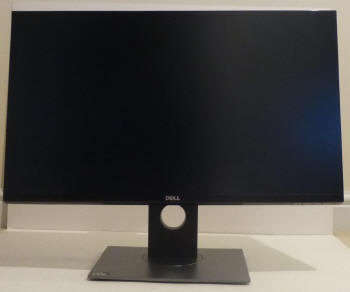
Above: front view of the screen. Click for larger versions
The S2716DG comes in a black and dark silver
design with a "zero bezel" frame. Around the sides and top there is a very
thin black plastic edge which measures only 1mm in thickness. Along the
bottom edge is a 13mm thick bezel made of matte black plastic, which still
looks extremely thin and sleek. There is an additional black border to the
panel along the top/sides before the image starts, so all in all there is
a total border of about 7.5mm there. There's a shiny silver Dell logo on
the front of the screen in the middle of the bottom bezel, but no other
writing or model designations. The bottom edge of the screen slopes away
from you slightly, so if you are at the right viewing height you can just
about see the OSD control buttons along the bottom right hand edge.
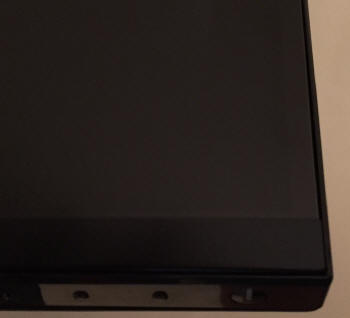
Above: view
of the bottom and edge borders. Click for larger version
The above photo shows the bezel and borders
in the bottom right hand corner of the screen. A thicker lower bezel
(13mm), then along the right hand side of the screen a 1mm plastic edge,
then a 6.5mm inner panel border (which you can just about make out here).
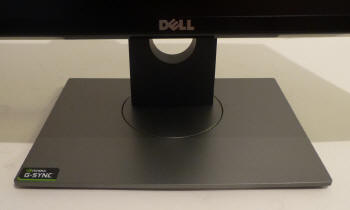
Above: view
of the base of the stand. Click for larger version
The base of the screen is finished in a dark
silver plastic which looks nice, and makes a change to the lighter silver
trim Dell have used before for some of their stands. The base measures 293
x 200 mm and provides a very sturdy support for the screen. There is a
cable tidy hole in the back of the stand as you can see above.

Above: view
of the back of the screen
The back of the screen is finished in a
glossy black plastic and so can attract dust and finger prints fairly
easily. The stand in the stock image above is lighter than it actually
appears in real life. The plastic is a darker silver than that.

Above:
stand attachment and VESA support
The stand is quickly and easily disconnected
via a release button if you want, and the screen is VESA 100 compliant for
wall and arm mounting. The screen is very thin and pretty light, so is
practical for other mounting options if you want.
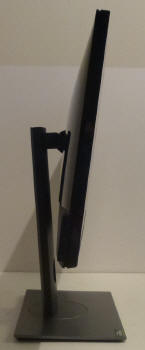
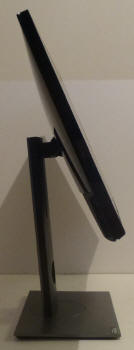
Above: full
tilt range shown. Click for larger versions
The side profile of the screen itself is
nice and thin, thanks to the use of W-LED backlighting. There is a good
tilt range available as shown above, and this movement is smooth and
pretty easy to use.
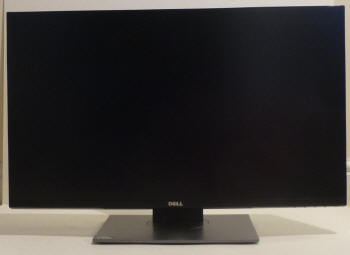
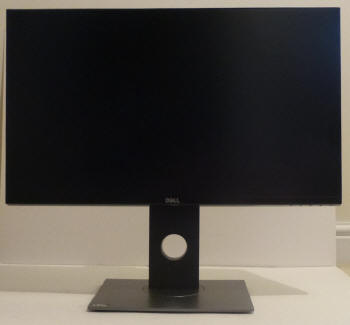
Above: full
height adjustment range shown, click for larger versions
The height adjustment is a little easier and
looser than the tilt, and provides a smooth movement from the stand. At its lowest setting
the bottom edge of the display is 55mm from the desk surface, and once
extended to maximum height it is 180mm. This gives a total 125mm
adjustment range. Side to side swivel and rotation are both fairly smooth,
and pretty easy to move as well. Overall the screen is sturdy and stable
on the stand and doesn't wobble. Dell have always been good at getting
their stands right, and this is no exception.
A summary of the screens ergonomic adjustments
is shown below:
|
Function |
Range |
Smoothness |
Ease of Use |
|
Tilt |
Yes |
Smooth |
Fairly stiff |
|
Height |
125mm |
Smooth |
Easy |
|
Swivel |
Yes |
Smooth |
Fairly stiff |
|
Rotate |
Yes |
Smooth |
Fairly stiff |
|
Overall |
Full range of adjustments
offered, and easy to use on the most part |
The materials were of a good standard and the
build quality felt very good as well. We liked the ultra-thin bezel design and
the darker silver stand was a nice change to the lighter silver Dell have used
before. There was a
very slight audible whine from the screen, but only if you listened very
closely to it. Certainly nothing you could detect in normal use from a normal
distance. The screen also remains pretty cool even during prolonged use.

Above:
interface connections on the back of the screen
The back of the screen provides the
video connections as shown above. There are only DisplayPort 1.2a and HDMI 1.4
inputs on this model given the use of NVIDIA G-sync. With it being a G-sync V
II module, HDMI is at least provided to give you some further flexibility
which is nice. Only the DP can support the high refresh rates and G-sync
though. On the back there is also the power connection, audio out, USB upstream and 2x USB 3.0 downstream.
In the middle is a service port by the way.
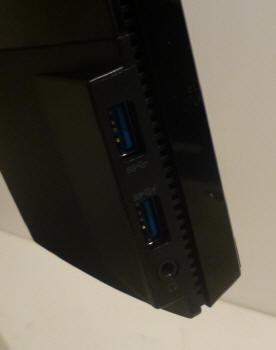
On the left hand edge of the screen are two easy
access USB 3.0 ports and the headphone out. Useful to have these more readily
available in this location we thought, even with the thin design of the
screen.

OSD Menu
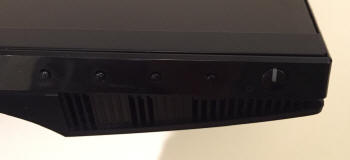
Above: OSD control buttons on the bottom edge of the screen. Click for
larger version
The OSD menu is accessed and controlled through 4
pressable buttons located on the bottom right hand edge of the screen, along
with a power button. These are actually quite difficult to use and press given
their position and stiffness. Pressing any of the buttons pops up a small quick
launch menu where you can get quick access to the preset modes and volumes
control. You can of course access the main menu as well.
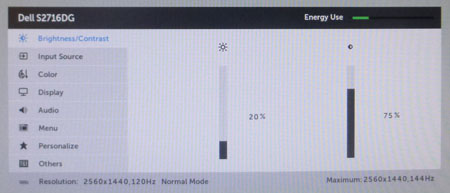
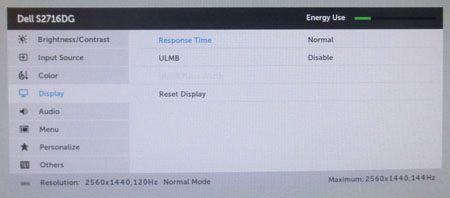
The main menu is familiar in design and layout if
you've ever used a Dell screen. It is split in to 8 sections down the left hand
side with options available then shown on the right. Of note is the 'display'
section where there are options for the
response time setting and
ULMB feature.
The other sections are fairly self-explanatory with all the usual features you'd
expect. You can personalize the quick launch options in the 'personalize' menu
which is handy. There weren't any preset modes available on this model
unfortunately, only a couple of differing colour temp modes. This is a bit of a
shame as we would have liked to be able to set up one for gaming and one for
desktop use at least.
All in all the menu was responsive and fairly easy
and intuitive to navigate. The location of the buttons was a bit fiddly though
and not as easy to use as some other screens. We suppose it's a sacrifice of
the ultra-thin bezel design.

Power Consumption
In terms of power consumption the manufacturer
lists a power on usage of 47.0W, and 0.5W in standby. We carried out our normal tests to
establish its power consumption ourselves.
|
 |
|
State and Brightness
Setting |
Manufacturer Spec (W) |
Measured Power Usage
(W) |
|
Default (75%) |
47.0 |
44.7 |
|
Calibrated (26%) |
- |
30.6 |
|
Maximum Brightness (100%) |
- |
56.1 |
|
Minimum Brightness (0%) |
- |
22.5 |
|
Standby |
0.5 |
0.5 |
|
We tested this ourselves and found that out of the
box the screen used 44.7W at the default 75% brightness setting. Once calibrated
the screen reached 30.6W consumption, and in standby it used only 0.5W. We have
plotted these results below compared with other screens we have tested.

We did notice an odd issue when the screen went to
sleep (if set in Windows instead of a screen saver or anything like that).
Normally with displays a simple move of your mouse or press of a keyboard button
would wake the screen again quickly. However, on the S2716DG we noticed that
this didn't seem to wake it. You could press one of the OSD control buttons on
the monitor itself which would wake it up again, or cycle it off/on from the
power button as well. This only happened when the screen was asleep and PC still
running. If you put the whole PC in sleep mode (and therefore the screen would
enter sleep mode), it would all come back on as normal when you woke the PC up
again.

Panel and Backlighting
|
Panel Manufacturer |
AU Optronics |
Colour Palette |
16.7 million |
|
Panel Technology |
TN Film |
Colour Depth |
8-bit? |
|
Panel Module |
M270DTN01.5 |
Colour space |
Standard gamut |
|
Backlighting Type |
W-LED |
Colour space coverage (%) |
~sRGB, ~72% NTSC |
Panel Part and Colour Depth
The Dell S2716DG features an
AU Optronics M270DTN01.5 TN Film panel which is capable of producing 16.7
million colours. While we do not have the full spec sheet for this particular
panel, but we believe it to be a true 8-bit colour depth as with other recent
2560 x 1440 TN Film gaming panels (Asus ROG Swift PG278Q, BenQ XL2730Z). This is a new panel that we've not seen in any screen before.
The part is confirmed when dismantling the screen:
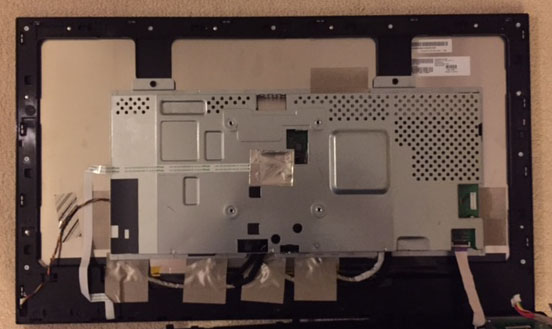
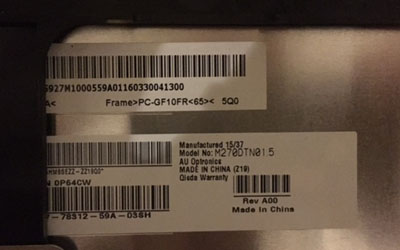
Screen
Coating
The
screen coating is a medium anti-glare (AG) offering. It isn't a semi-glossy
coating, and isn't as light as some modern IPS type panels either. It's in
keeping with other TN Film panels we've tested. Thankfully it isn't a heavily
grainy coating like some old IPS panels feature, although there is some
graininess noticeable. It retains its anti-glare properties to avoid too many
unwanted reflections of a full glossy coating, but does not produce an too
grainy or dirty an image that some thicker AG coatings can. There were some
slight cross-hatching patterns visible on the coating as well but only if you
looked very closely.
Backlight Type and Colour Gamut
The screen uses a White-LED (W-LED) backlight unit
which has become very popular in today's market. This helps reduce power
consumption compared with older CCFL backlight units and brings about some
environmental benefits as well. The W-LED unit offers a standard colour gamut
which is approximately equal to the sRGB colour space.
Anyone wanting to work with wider colour spaces would need to consider wide
gamut CCFL screens or the newer range of GB-r-LED type displays available
now. If
you want to read more about colour spaces and gamut then please have a read of
our
detailed article.
Backlight
Dimming and Flicker
We tested the screen to establish the methods used
to control backlight dimming. Our in depth article talks in more details about a
common method used for this which is called
Pulse Width Modulation (PWM). This in itself gives cause for concern to some
users who have experienced eye strain, headaches and other symptoms as a result
of the flickering backlight caused by this technology. We use a photosensor +
oscilloscope system to measure backlight dimming control
with a high level of accuracy and ease. These tests allow us to establish
1) Whether PWM is being used to control the
backlight
2) The frequency and other characteristics at which this operates, if it is used
3) Whether a flicker may be introduced or potentially noticeable at certain
settings
If PWM is used for backlight dimming, the higher
the frequency, the less likely you are to see artefacts and flicker. The duty
cycle (the time for which the backlight is on) is also important and the shorter
the duty cycle, the more potential there is that you may see flicker. The other
factor which can influence flicker is the amplitude of the PWM, measuring the
difference in brightness output between the 'on' and 'off' states. Please
remember that not every user would notice a flicker from a backlight using PWM,
but it is something to be wary of. It is also a hard thing to quantify as it is
very subjective when talking about whether a user may or may not experience the
side effects.
100% 50%
0%



Above scale = 1
horizontal grid = 5ms
At 100% brightness a constant voltage is applied
to the backlight. As you reduce the brightness setting to dim the backlight a
Direct Current (DC) method is used, as opposed to any form of PWM. This applies
to all brightness settings from 100% down to 0%. The screen is flicker free as a
result, as advertised.
|
Pulse Width
Modulation Used |
No |
|
Cycling
Frequency |
n/a |
|
Possible
Flicker at |
|
|
100% Brightness |
No |
|
50% Brightness |
No |
|
0% Brightness |
No |
For an up to date list of all flicker-free (PWM free) monitors please see our
Flicker Free Monitor Database.

Contrast
Stability and Brightness
We wanted to see how much variance there was in
the screens contrast as we adjusted the monitor setting for brightness.
In theory, brightness and contrast are two independent parameters, and good
contrast is a requirement regardless of the brightness adjustment.
Unfortunately, such is not always the case in practice. We recorded the
screens luminance and black depth at various OSD brightness settings, and
calculated the contrast ratio from there. Graphics card settings were left at
default with no ICC profile or calibration active. Tests were made using an
X-rite i1 Display Pro colorimeter. It should be noted that we used the
BasICColor calibration software here to record these, and so luminance at
default settings may vary a little from the LaCie Blue Eye Pro report.
|
OSD
Brightness |
Luminance
(cd/m2) |
Black
Point (cd/m2) |
Contrast
Ratio
( x:1) |
|
100 |
327.83 |
0.36 |
911 |
|
90 |
294.46 |
0.32 |
920 |
|
80 |
263.10 |
0.28 |
940 |
|
70 |
233.64 |
0.25 |
935 |
|
60 |
209.06 |
0.23 |
909 |
|
50 |
183.52 |
0.20 |
918 |
|
40 |
153.45 |
0.17 |
903 |
|
30 |
126.23 |
0.14 |
902 |
|
20 |
97.85 |
0.11 |
890 |
|
10 |
68.11 |
0.07 |
973 |
|
0 |
38.45 |
0.04 |
961 |
|
Total Luminance Adjustment Range
(cd/m2) |
289.38 |
Brightness OSD setting controls backlight? |
 |
|
Total Black Point
Adjustment Range (cd/m2) |
0.32 |
|
Average Static Contrast Ratio |
924:1 |
PWM Free? |
 |
|
Recommended OSD setting
for 120 cd/m2 |
28 |
The brightness control gave us a very good range
of adjustment. At the top end the maximum luminance reached 328
cd/m2 which was
only a little shy of the specified maximum brightness of 350 cd/m2
from the manufacturer. There was a decent 289 cd/m2 adjustment range
in total, and so at the minimum setting you could reach down to a low luminance
of 38 cd/m2. This should be adequate for those wanting to work in
darkened room conditions with low ambient light. A setting of 28 in the OSD menu should return you a
luminance of around 120 cd/m2 at default settings.
It should be noted that the
brightness regulation is controlled without the need for
Pulse Width Modulation, using a Direct Current (DC) method for all
brightness settings between 100 and 0% and so the screen is flicker free as
advertised.

We have plotted the
luminance trend on the graph above. The screen behaves as it should in this
regard, with a reduction in the luminance output of the screen controlled by the
reduction in the OSD brightness setting. This is pretty much a linear relationship as you
can see.

The average contrast ratio of
the screen was good for a TN Film panel with an average of 9241. This was mostly
stable across the brightness adjustment range as shown above although it did
seem to go a bit higher at 20% brightness and less.

Testing
Methodology
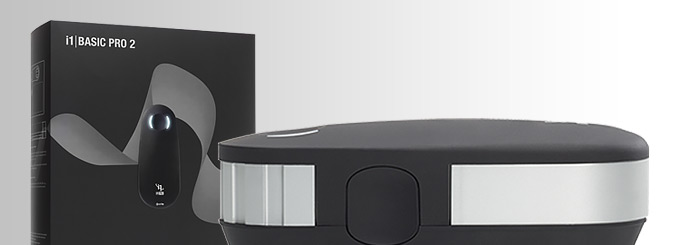
An
important thing to consider for most users is how a screen will perform out of
the box and with some basic manual adjustments. Since most users won't have
access to hardware colorimeter tools, it is important to understand how the
screen is going to perform in terms of colour accuracy for the average user.
We restored our graphics card to default settings
and disabled any previously active ICC profiles and gamma corrections. The
screen was tested at default factory settings using our new
X-rite i1
Pro 2 Spectrophotometer combined with
LaCie's Blue Eye Pro software suite. An X-rite i1 Display Pro colorimeter was
also used to verify the black point and contrast ratio since the i1 Pro 2
spectrophotometer is less
reliable at the darker end.
Targets for these tests are as follows:
-
CIE Diagram - validates the colour space
covered by the monitors backlighting in a 2D view, with the black triangle representing the
displays gamut, and other reference colour spaces shown for comparison
-
Gamma - we aim for 2.2 which is the default
for computer monitors
-
Colour temperature / white point - we aim
for 6500k which is the temperature of daylight
-
Luminance - we aim for 120
cd/m2, which is
the recommended luminance for LCD monitors in normal lighting conditions
-
Black depth - we aim
for as low as possible to maximise shadow detail and to offer us the best
contrast ratio
-
Contrast ratio - we aim
for as high as possible. Any dynamic contrast ratio controls are turned off here
if present
-
dE average / maximum -
as low as possible.
If DeltaE >3, the color displayed is significantly different from the
theoretical one, meaning that the difference will be perceptible to the
viewer.
If DeltaE <2, LaCie considers the calibration a success; there remains a
slight difference, but it is barely undetectable.
If DeltaE < 1, the color fidelity is excellent.

Default Performance and
Setup
Default settings of the screen were as follows:
|
Monitor OSD Option |
Default Settings |
|
Preset mode |
Standard |
|
Brightness |
75 |
|
Contrast |
75 |
|
RGB |
n/a |

Dell S2716DG - Default Settings




|
|
Default Settings |
|
luminance (cd/m2) |
266 |
|
Black Point (cd/m2) |
0.29 |
|
Contrast Ratio |
920:1 |
Initially out of the box the screen was set in the
default 'standard' preset. You could tell the screen was using a
standard gamut backlight and the image looked reasonably good to the naked eye, but too bright for
comfortable use. Colour balance felt pretty good, but the image appeared a bit
washed out. We went ahead and measured the default state with
the i1 Pro 2.
The
CIE diagram on the left of the image confirms that the monitors colour gamut
(black triangle) is roughly equal to
the sRGB colour space. There is some over-coverage in some shades, particularly
in blues and greens where it extends a fair way beyond the sRGB reference. It's not by anything
major, but you may find some slight over-saturation in some colours. Default
gamma was the main problem from a general-use point of view, being recorded at
1.9 average, leaving it with a big 15% deviance
from the target. This is firmly a gaming screen though and perhaps it is a
deliberate factory setup to achieve a brighter image for gaming. It's not the
first gaming screen we've seen set up in this way. For desktop and
other non-gaming uses we would like something closer to 2.2. The screen is
lacking any gamma settings in the OSD menu so you are unable to alter the gamma
without changing it at a graphics card level or through profiling with a
calibration tool. That might be a pain for some users, although you may find it
preferable at 1.9 anyway for gaming and you can try our calibrated ICC
profile (see next section) as well which will hopefully help.

White point was a better story, being measured at 6617k
and only ever so slightly
too cool from the target of 6500k but with a low 2% deviance. The screen was set
in the default 'standard' colour temp mode incidentally with RGB not available
to tweak unless you enter the 'custom color' mode which we will do later for
calibration.
Luminance was recorded at a very bright 266
cd/m2 which is
too high for prolonged general use. The screen was set at a default 75%
brightness in the OSD menu but that is easy to change of course to reach a more
comfortable setting without impacting any other aspect of the setup. The black
depth was 0.29 cd/m2 at this default
brightness setting, giving us a good static contrast ratio (for a TN Film panel) of
920:1.
Colour accuracy was an issue because of the low
1.9 gamma, with a dE
average of 5.4 and maximum of 9.5 measured.
Testing the screen
with colour gradients revealed smooth gradients with some slight gradation in
semi-dark tones and some fairly noticeable gradation
evident in the darkest tones. Overall the screen is more set up for gaming needs
as you might expect from a model like this, although you'll still need to tone
down the brightness setting we expect. Getting it in to a better gamma for other
uses is a bit more tricky without an actual gamma control in the main menu.

Calibration
We used the
X-rite i1
Pro 2 Spectrophotometer combined with the LaCie Blue Eye Pro
software package to achieve these results and reports. An X-rite i1 Display Pro
colorimeter was used to validate the black depth and contrast
ratios due to lower end limitations of the i1 Pro device.
|
Monitor OSD Option |
Default Settings |
|
Preset mode |
Custom Color |
|
Brightness |
26 |
|
Contrast |
75 |
|
RGB |
97, 99, 96 |

Dell S2716DG - Calibrated Settings

|
|
Calibrated Settings |
|
luminance (cd/m2) |
119 |
|
Black Point (cd/m2) |
0.14 |
|
Contrast Ratio |
876:1 |
All the OSD
changes listed in the table above allowed us to obtain an
optimum hardware starting point and setup before software level changes would be
made at the graphics card level. We left the LaCie software to calibrate
to "max" brightness which would just retain the luminance of whatever brightness
we'd set the screen to, and would not in any way try and alter the luminance at
the graphics card level, which can reduce contrast ratio. These adjustments
before profiling the screen would help preserve tonal values and limit
banding issues as much as possible. After this we let the software carry out the LUT adjustments and create an
ICC profile. The main thing we needed the software profiling stage to
correct here would be the gamma curve, since we know that by default it was 1.9
average, and needed to be nearer to 2.2.
Average gamma was now corrected to 2.2 average,
correcting the 15% deviance we'd seen out of the box. The white point was maintained at an accurate level, measured at 6502k
(0% deviance) and correcting the minor 2% deviance we had out of the box. Luminance had been improved thanks to the adjustment to the
brightness control and was now being measured at 119
cd/m2. This
left us a black depth of 0.14 cd/m2 and maintained a good static contrast ratio
(for a TN Film panel) of
876:1. Colour accuracy of the resulting
profile was very good, with dE average of 0.6 now.
Testing the screen with colour gradients revealed
mostly smooth gradients with some minor gradation evident in darker tones as you
see from most screens, and some minor banding introduced in the darkest tones due to the gamma
correction at the graphics card level. Unfortunately this small level of banding
is unavoidable when you need to correct gamma in this way through graphics card
adjustments.
You can use our settings and
try our calibrated ICC profile if you wish, which are available in
our ICC profile database. Keep in mind that results will vary from one
screen to another and from one computer / graphics card to another.

Calibration Performance Comparisons

The comparisons made in this section try to give
you a better view of how each screen performs, particularly out of the box which
is what is going to matter to most consumers. When comparing the default factory
settings for each monitor it is important to take into account several
measurement areas - gamma, white point and colour accuracy. There's no point
having a low dE colour accuracy figure if the gamma curve is way off for
instance. A good factory calibration requires all 3 to be well set up. We have
deliberately not included luminance in this comparison since this is normally
far too high by default on every screen. However, that is very easily controlled
through the brightness setting (on most screens) and should not impact the other
areas being measured anyway. It is easy enough to obtain a suitable luminance
for your working conditions and individual preferences, but a reliable factory
setup in gamma, white point and colour accuracy is important and not as easy to
change accurately without a calibration tool.
From these comparisons we can also compare the
calibrated colour accuracy, black depth and contrast ratio. After a calibration
the gamma, white point and luminance should all be at their desired targets.

Default setup of the screen out of the box was
ok for gaming needs, but really fairly poor for more general day to day
office-type uses. The white point was close to the 6500k target at least, but
the main issue with the screen was the 1.9 gamma. Like we say, fine for gaming
really, and perhaps preferred in some cases, but we'd have liked some control
over the gamma from the screen to get it nearer to 2.2 for other uses. This had
a knock-on effect to the dE colour accuracy measurements as well. The contrast
ratio was good for a TN Film panel at least. The S2716DG was actually fairly
similar to the BenQ XL2730Z and Acer XG270HU which also had a 1.8 - 1.9 default
gamma and poor dE. The take away from this is that the screen is set up for
gaming out of the box, and so for other uses it will need some tweaking ideally.


The display was ok when it came to black depth
and contrast ratio for a TN Film panel. With a calibrated contrast ratio
of 876:1 it was comparable to some of the other TN Film screens we've tested,
like the Acer XG270HU (828:1), Asus ROG Swift PG278Q (858:1) and BenQ XL2730Z
(917:1). It was not quite as high as some modern IPS-type panels like the
Dell U2515H
(1138:1) for instance, or more gamer orientated IPS offerings like the Acer
XB270HU (1000:1) or Asus ROG Swift PG279Q (989:1). Of course none of these IPS screens can compete with VA panel types
which can reach over 2000:1 easily, and
even close to 5000:1 in the case of the 24"
Eizo FG2421 shown here.
|
Check Pricing and Buy - Direct Links
|
|
Amazon USA |
Amazon
UK |
Amazon GER |
Amazon CAN
|
|
TFTCentral is a participant
in the Amazon Services LLC Associates Programme, an affiliate
advertising programme designed to provide a means for sites to earn
advertising fees by advertising and linking to Amazon.com, Amazon.co.uk,
Amazon.de, Amazon.ca and other Amazon stores worldwide. We also
participate in a similar scheme for Overclockers.co.uk. |

Viewing Angles
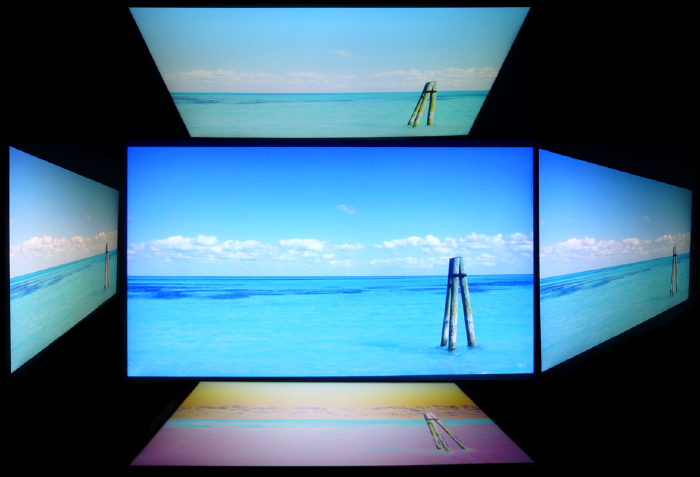
Above: Viewing
angles shown from front and side, and from above and below. Click for
larger image
Viewing angles of the screen were as you might
expect from a TN Film panel. Unfortunately this panel technology is inherently
poor in this field, and so viewing angles are more restrictive than other
competing technologies like IPS and VA variants. Although the manufacturer will
quote a viewing angle of 170 / 160 (a classic indication that a TN Film panel is
being used by the way if in doubt), in practice there are some obvious contrast
and colour tone shifts horizontally, and especially vertically.
As you move your head from side to side in a
horizontal plane, there is a contrast shift and the image becomes darker and
introduces a slight green/yellow hue. As you move to a wider angle the image can
become more washed out as well. Vertically the fields of view are more
restrictive still. From above the image becomes pale and washed out, while from
below there is a characteristic TN Film darkening of the image. Unfortunately
vertically the viewing angles will introduce noticeable shifts in the contrast
and colour tone of the image which mean that for any colour critical work it is
not really very well suited. TN Film panels have long suffered from these
restrictive viewing angles due to the nature of their pixel structure. They are
still fine for a single user for general use and certainly the TN Film panels
offer their advantages when it comes to
pixel response
times and refresh rate for gaming. If however, you were hoping to do any
colour critical or photography work you may find these shifts in the appearance
of the image difficult. An IPS-type panel would probably be a wiser choice if
you were looking for a screen with much wider viewing angles but having said
that you are probably mainly interested in gaming if you are considering this
screen. Remember, the S2716DG is specifically designed for gaming, and so you
will have to live with some of the sacrifices of TN Film to get the kind of
gaming performance and features offered here. There are some high refresh rate
gaming IPS panels available now as well which can offer better viewing angles
than TN Film models, although they are normally priced higher and have some
other characteristic differences, and so TN Film models like this still have
their place for many users.
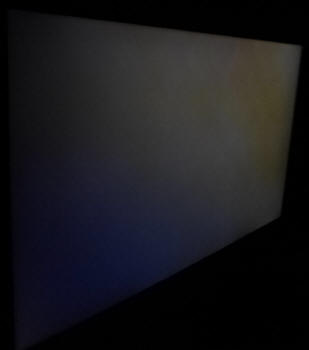
Above: View of an
all black screen from the side. Click for larger version
On a black image there is a moderate pale grey
tint introduced to the image when viewed from a wide angle. This isn't too
severe and shouldn't present any real problems in practice. Certainly not the
obvious white glow you get from most modern IPS-type panels in similar
situations and fairly standard for a TN Film panel. Very similar to what we have
seen from other recent gaming screens like the Asus ROG Swift PG278Q and BenQ
XL2730Z. The glow you see from most modern IPS panels, including the high
refresh rate IPS models like the Asus ROG Swift PG279Q and Acer XB270HU can put
off some users. So on the one hand, those IPS models have much better general
viewing angles than the TN Film models, but they do show more glow which some
people find an issue.

Panel Uniformity
We wanted to test
here how uniform the brightness was across the screen, as well as identify any
leakage from the backlight in dark lighting conditions. Measurements of the luminance
were taken at 35 points across the panel on a pure
white background. The measurements for luminance were taken using BasICColor's calibration
software package, combined with an X-rite i1 Display Pro
colorimeter with a central point on the screen calibrated to 120 cd/m2. The below uniformity diagram shows the difference, as a percentage,
between the measurement recorded at each point on the screen, as compared with the
central reference point.
It is worth
noting that panel uniformity can vary from one screen to another, and can depend
on manufacturing lines, screen transport and other local factors. This is only a
guide of the uniformity of the sample screen we have for review.

Uniformity of Luminance

The luminance uniformity of the screen was
good with only the left hand and bottom
edges showing any real significant variation. Here the backlight was a
little darker, down by about 19% maximum in the worst cases (top left hand
corner = 101
cd/m2).
Overall the uniformity was good, with 71% of the screen with a 10% deviance
from the centrally calibrated point.

Backlight Leakage
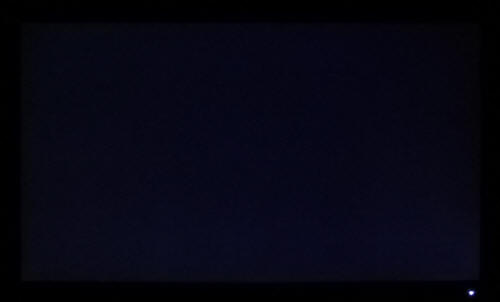
Above: All black screen in a darkened room. Click for larger version
As usual we also tested the screen with an all
black image and in a darkened room. A camera was used to capture the result. The
camera showed there was some clouding detected along the lower edge of the
screen and in the bottom right hand corner but it was very slight.
Note: if you want to test your own screen for
backlight bleed and uniformity problems at any point you need to ensure you have
suitable testing conditions. Set the monitor to a sensible day to day brightness
level, preferably as close to 120
cd/m2
as you can get it (our tests are once the screen is calibrated to this
luminance). Don't just take a photo at the default brightness which is almost
always far too high and not a realistic usage condition. You need to take the
photo from about 1.5 - 2m back to avoid capturing viewing angle characteristics,
especially on IPS-type panels where off-angle glow can come in to play easily.
Photos should be taken in a darkened room at a shutter speed which captures what
you see reliably and doesn't over-expose the image. A shutter speed of 1/8
second will probably be suitable for this.

General and Office Applications
The S2716DG feature a large 2560 x 1440 WQHD
resolution which is still pretty rare for gaming 27" screens. There's only been
a few released so far with TN Film panels - the Asus ROG Swift PG278Q, Acer
XG270HU and the BenQ XL2730Z. So in this space there's still a limited choice
when it comes to high resolution gaming screens based on this technology, with
most other models still offering only 1920 x 1080. This extra resolution is
excellent both for gaming and for other uses.
The pixel pitch of 0.233 mm is quite small as a
result though, and by comparison a standard 16:10 format 24" model has a pixel
pitch of 0.270mm and a 30" model has 0.250mm. These ultra-high resolution 27"
models offer a tight pixel pitch and therefore small text as well. We found it
quite a change originally coming from 21.5 - 24" sized screens back in the day,
even those offering quite high resolutions and small pixel pitches. Although now
we are very used to working with 27" 1440p screens all the time and find them
very comfortable and a significant upgrade over 1080 / 1200p models. Some users
may find the small text a little too small to read comfortably, and we'd advise
caution if you are coming from a 19" or 22" screen for instance where the pixel
pitch and text are much larger. The extra screen size takes some getting used to
over a few days as there really is a lot of room to work with but once you do,
it's excellent. For those wanting a high resolution for their work, this is a
really good option. The image was very sharp and crisp and text was very clear.
With its
WQHD display, you enjoy 77% more desktop space than a full HD screen to spread
out your windows and palettes.
The
frameless thin bezel design mean that the S2716DG could be easily integrated
into a multi-screen set up if you wanted. The moderate AG coating of the
TN Film panel could be considered a bit grainy, especially on white office
backgrounds to a lot of people. It's not as clear as modern IPS coatings or any
semi-glossy solution. Still, it's not as grainy as old IPS panels and is on par
with other TN Film matrices we've tested. Perhaps the main issue with this panel
technology though is the restrictive viewing angles, making contrast and colour
tone shifts a bit of a problem when it comes to colour critical work. They are
the same here as other TN Film panels, being restrictive especially vertically.
The screen is fine when viewed head on though really for office and text work,
but for colour critical work or photo editing etc you'd be better off with an
IPS-type panel.
The default setup of the screen was a bit restrictive for normal uses, as the
gamma is set up more for gaming, and hard to adjust without a calibration tool
(or maybe our calibrated ICC profile).
The brightness
range of the screen was very good, with the ability to offer a luminance between
328 and 38 cd/m2. This should mean the screen is perfectly useable in
a wide variety of ambient light conditions, including darkened rooms. A setting
of ~28 in the OSD brightness control should return you a luminance close to 120
cd/m2 out of the box. On another positive note, the brightness
regulation is controlled without the need for the use of the now infamous
Pulse-Width Modulation (PWM), and so those who suffer from eye fatigue or
headaches associated with flickering backlights need not worry.
There was a very
feint audible whine from the screen but you really had to press your ear up to
the top of the screen to notice it. The screen remains fairly cool even during
prolonged use. There are some extras offered on this screen with audio out,
headphone socket and 4x USB 3.0 ports provided. There isn't anything else like
an ambient light sensor or card
reader which can be useful in office environments. This is primarily a gaming
screen remember. There was a good range of ergonomic adjustments from the stand
though, and it's good to see Dell haven't reverted to a more basic stand as they
have with some multimedia models in the past.

Above: photo of
text at 2560 x 1440 (top) and 1920 x 1080 (bottom)
The screen is designed to run at its native
resolution of 2560 x 1440 and at a 144Hz native refresh rate. However,
if you want you are able to run the screen outside of this resolution. We tested
the screen at a lower 1920 x 1080 resolution to see how the screen handles the
interpolation of the resolution, while maintaining the same aspect ratio of
16:9. At native resolution the text was very sharp and clear. When running at a 1080p resolution the text is still
reasonably clear, with moderate
levels of blurring. You do lose a lot of screen real-estate as well of course
but the image seems to be quite well interpolated if needed.

Gaming Introduction
The S2716DG is aimed at a gaming audience
primarily. The new screen offers you a 2560 x 1440 resolution TN Film panel
which until about 15 months ago was not offered in the market. Now we've seen a
few 1440p TN Film gaming screens emerge, and the extra resolution compared with
1080p is certainly a welcome upgrade. This TN Film panels also offers a native
144Hz refresh rate and 1ms G2G rated response time, so is of course an ideal
option for fast moving content. This has then been combined with NVIDIA
G-sync for the benefits of dynamic refresh rate control. This is
particularly important given the added resolution here, as the demands on your
system running games at 1440p @ 144Hz are very high.
There is also the accompanying ULMB blur reduction mode
provided here. This allows for a strobing backlight to
reduce perceived motion blur in dynamic content. Have a read of
our blur
reduction backlight article which talks about the benefits of these kind of
technologies in more detail. It's a feature some people really like when it
comes to dynamic content, primarily gaming. It can really help reduce the motion
blur you see on the screen due to the way LCD technology operates. As with other
screens which support ULMB, it cannot be used at the same time as G-sync since
that operates with a dynamic refresh rate by its nature. You can enable ULMB if
you would rather use that to G-sync when your screen is set to 85, 100 or 120Hz
refresh rates. It does not work at 144Hz refresh rate. We will look at the ULMB operation
in more detail later.
Although NVIDIA G-sync is offered here, NVIDIA 3D Vision is not supported
unfortunately.
Correction 19/2/16 - PCmonitors.info have
confirmed that the screen does support 3D Vision after all!
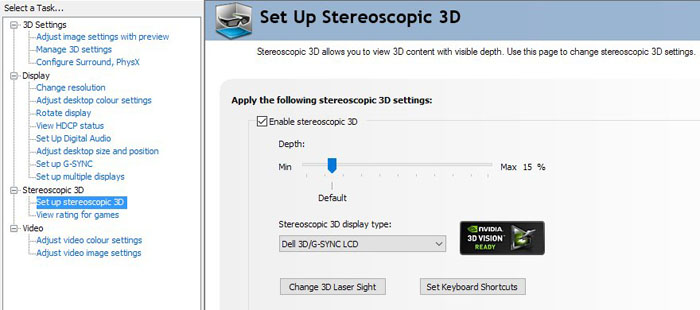
It should be noted that this model is TN Film
based, and so can't offer the all-round performance in other areas that the new
wave of fast IPS panels (Acer Predator XB270HU, Asus ROG Swift PG279Q etc) can
offer. We have made some of those comparisons elsewhere in this review.
|
2560 x 1440 Resolution |
 |
|
TN Film panel technology |
 |
|
Max refresh rate support
|
144Hz |
|
G-sync support |
 |
|
Blur Reduction mode |
 |
|
NVIDIA 3D Vision |
 |

Responsiveness and Gaming
|
Quoted G2G Response Time |
1ms G2G |
|
Quoted ISO Response Time |
n/a |
|
Panel Manufacturer and
Technology |
AU Optronics TN Film |
|
Panel Part |
M270DTN01.5 |
|
Overdrive Used |
Yes |
|
Overdrive Control Available to
User |
Response Time |
|
Overdrive Settings |
Normal, Fast |
The S2716DG is rated by Dell as having a 1ms G2G response time, which indicates the panel uses
overdrive /
response time compensation (RTC) technology to boost pixel transitions
across grey to grey changes. There is user control over the overdrive impulse
within the OSD menu using the 'Response Time' option, with the 1ms spec
supposedly relating to the fastest mode available ("fast"). The
part
being used is the
AU Optronics M270DTN01.5 TN Film panel. Have a read about response time in
our
specs section if you need additional information about this measurement.
We will first test the screen using our thorough
response time testing method. This uses an oscilloscope and photosensor to
measure the pixel response times across a series of different transitions, in
the full range from 0 (black) to 255 (white). This will give us a realistic view
of how the monitor performs in real life, as opposed to being reliant only on a
manufacturers spec. We can work out the response times for changing between many
different shades, calculate the maximum, minimum and average grey
to grey (G2G) response times, and provide an evaluation of any overshoot present
on the monitor.
We use an
ETC M526
oscilloscope for these measurements along with a custom photosensor device.
Have a read of
our response time measurement article for a full explanation of the testing methodology and reported
data.
Response Time Setting Comparison

The S2716DG comes with a user control for the
overdrive impulse available within the OSD menu in the 'display' section. There are
2 options available here under the
'Response Time' setting. First of all we carried out a fairly small set
of measurements and motion tests in both settings for the
purposes of identifying which was the optimum response time setting. There tests
were conducted at 144Hz refresh rate.

Firstly we tested the response times with the
setting at the default 'normal'. Response times measured here were fast, with an
average of only 2.8ms G2G. There was some moderate levels of overshoot
introduced on a couple of transitions here, but overall it was at low levels.
Motion clarity tests revealed smooth movement and no obvious dark or pale
trailing, which could be caused by high overshoot. Some users have reported some
artefacts on white backgrounds which is down to the overshoot seen on some
transitions to white it seems.

Pushing the response time setting up to the
maximum 'fast' setting improved the overall response time measurements a little,
now at 2.2ms G2G. However, it was at the cost of very high levels of overshoot
which are very obvious in practice as well. This mode should be avoided, stick
to 'normal'.

Refresh Rate
We tested the response time behaviour in the
optimum "normal" setting at a variety of refresh rates. We know form past
experience with other displays that the response time behaviour can sometimes
change at different refresh rates. With this screen supporting G-sync, the
dynamic refresh rate could therefore influence in theory the response times if
they were to vary much across the refresh frequencies.
Here we have measurements at 60Hz and 144Hz:
60Hz Refresh Rate

144Hz Refresh
Rate

There was little difference in response times
it seemed, as even at 60Hz they were very fast (3.4ms G2G). There did appear to
be some slight improvement as you pushed the refresh rate higher, where they
reached 2.8ms G2G average at 144Hz. It's not a huge difference, and the screen
is still very fast at lower refresh rates. This should mean that even if you're
running at lower refresh rates, for instance from an external console or device,
then the pixel transitions are still very fast here which is good news.
Interestingly the overshoot behaviour varied at
different refresh rates for some reason. Some transitions showed some overshoot
at moderately high levels when running at 60Hz (e.g. the 0 - 255 transition,
12.1% overshoot), but at 144Hz that had disappeared. On the other hand,
transitions such as 150 - 255 showed low levels of overshoot at 60Hz (5.7%) but
higher levels at 144Hz (13.2%). All in all, it levelled out pretty much but it
seemed the G-sync module did dynamically control the overdrive impulse at
differing refresh rates, and with some slightly different characteristics as you
went when it came to overshoot. The overall overshoot in this normal response
time mode was low anyway so it wasn't really an issue, just something
interesting to note about the behaviour of the overdrive impulse.
The higher you can run the screen the better
though, as there is some small benefit in response times it seems, not to
mention obvious improvements in frame rates and perceived fluidity / motion
clarity as a direct result of the increased refresh rate. Also, while the overshoot % remained pretty similar overall, the
duration of the overshoot was reduced as you increased the refresh rate due to
the additional frames being pushed to the screen.
The below graphs show as an example the changing
overshoot behaviour for the 0 - 255 transition as you increase the refresh rate
from 60Hz up to 144Hz. You will see the peak at the top reduces down to nothing
with the change in refresh rate:
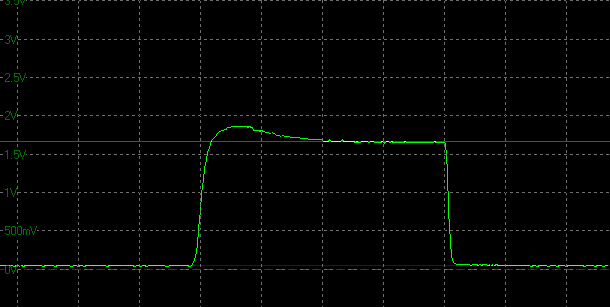
60Hz refresh rate (scale = 20ms)
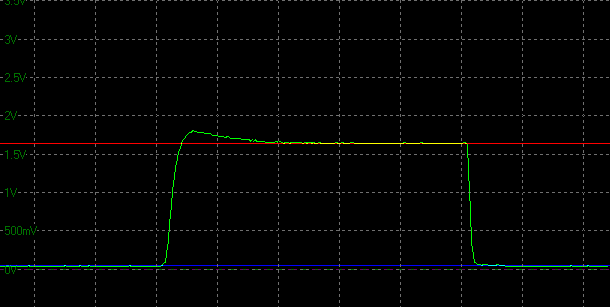
100Hz refresh rate (scale = 20ms)
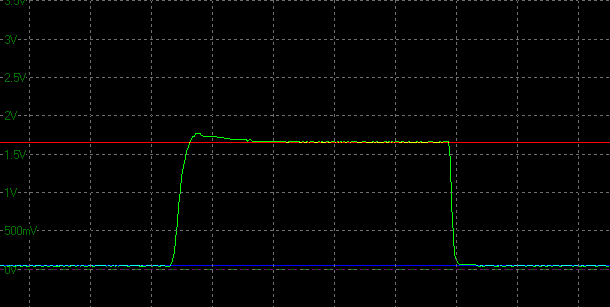
120Hz refresh rate (scale = 20ms)
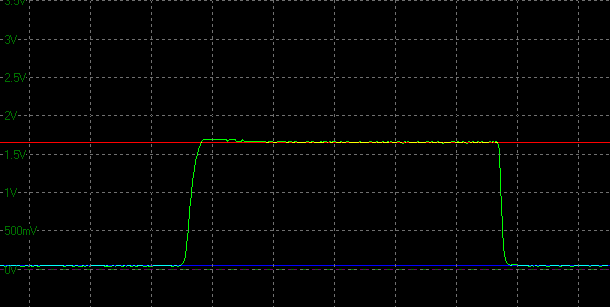
144Hz refresh rate (scale = 20ms)

More Detailed Measurements
Response Time setting = Normal, 144Hz Refresh Rate
Having established that the normal setting
offered the best response/overshoot balance we carried out our normal wider
range of measurements as shown below. We used the maximum refresh
rate of 144Hz.
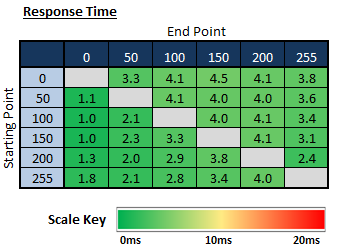
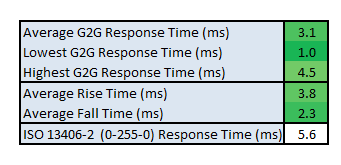
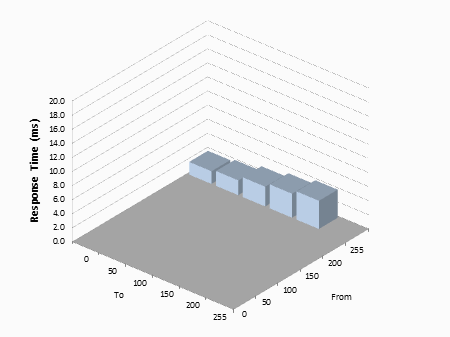
The average G2G response time was more accurately
measured at 3.1ms which was excellent.
Transitions were pretty stable across all the changes, whether they were changes
from dark to light (rise times) or from light to dark (fall times). The fall
times were a little faster. Some transitions did reach down to the specified 1ms
G2G as well, even at this normal response time setting.
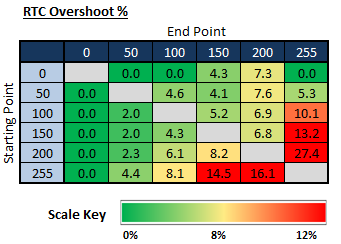
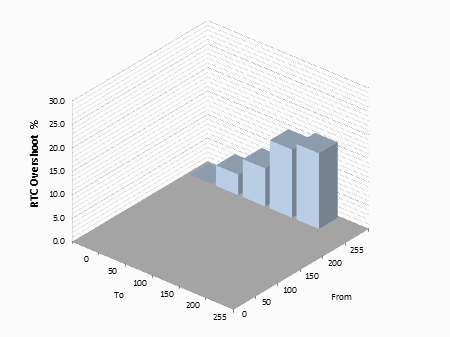
There was some moderate levels of overshoot at
this setting, particularly it seemed on changes to white (x > 255) where there
was overshoot up to 27.4% maximum. Overall there were only a few transitions
where it was noticeable and most transitions showed very low levels of
overshoot. Not too bad although perhaps a slightly less aggressive overdrive
impulse would have been preferred to cut back the overshoot completely, even at
the cost of slightly slower response times.

Display Comparisons
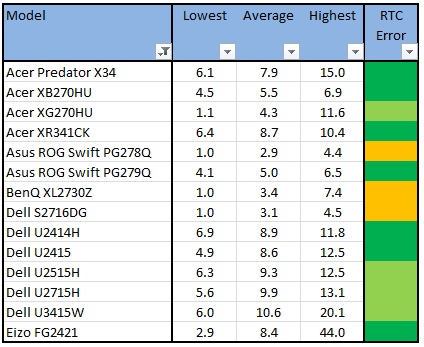
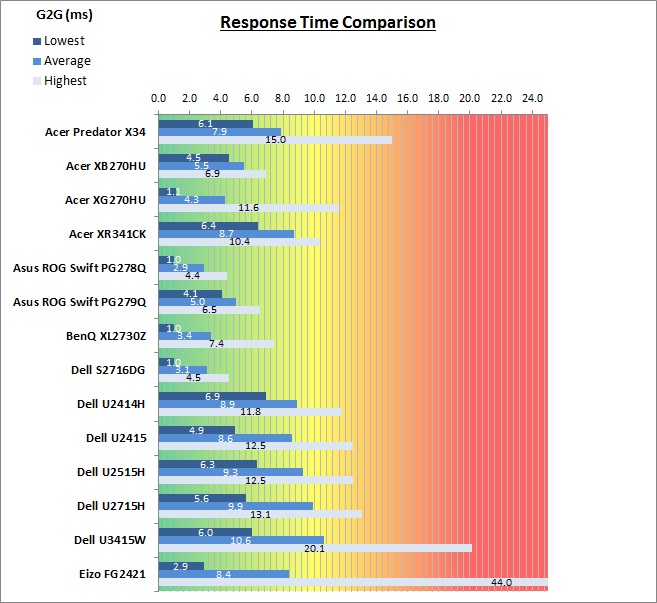
The above comparison table and graph shows you the
lowest, average and highest G2G response time measurement for each screen we
have tested with our oscilloscope system. There is also a colour coded mark next
to each screen in the table to indicate the RTC overshoot error, as the response
time figure alone doesn't tell the whole story.
Overall the responsiveness of the S2716DG was very
comparable to some of the best TN Film gaming screens we've tested. With a 3.1ms
G2G average and low/moderate overshoot, it was perhaps ever so slightly better
than the excellent
Asus ROG Swift PG278Q and
BenQ XL2730Z which showed slightly more overshoot than the Dell if you refer
to those reviews. There was very little in it, but there was just slightly less
apparent trailing on the Dell we felt. These models are a bit faster than the
high refresh IPS panels available, which reach down to about 5ms G2G average in
our tests, although those are free from any noticeable overshoot. Some users
prefer the "feel" of the TN Film panels and their fluidity, and combined with a
144Hz refresh rate and G-sync you have a lovely, smooth gaming experience here.
If you enable ULMB instead you also get a very low level of perceived motion
blur and improved image clarity on moving scenes.
The screen was also tested using the chase test in
PixPerAn for the following display comparisons. As a reminder, a series of
pictures are taken on the highest shutter speed and compared, with the best case
example shown on the left, and worst case example on the right. This should only
be used as a rough guide to comparative responsiveness but is handy for a
comparison between different screens and technologies as well as a means to
compare those screens we tested before the introduction of our oscilloscope
method.

27"
1ms
G2G AU Optronics TN Film @ 144Hz (Response Time = Normal)
In practice the Dell S2716DG performed best with
the response time setting at normal. There were low levels of blurring evident, the image looked sharp
and there were only low levels of overshoot detected. You can see some slight
dark trailing in places behind the moving speech bubble for instance. The support for higher refresh rates up to
144Hz provided additional levels of motion clarity and image smoothness which
surpassed what was possible from 60Hz panels. The additional G-sync support for
NVIDIA users will also be of real benefit.

27"
1ms
G2G AU Optronics TN Film @ 144Hz (Response Time = Normal)

27"
1ms
G2G AU Optronics TN Film @ 144Hz (OD = Normal)

27"
1ms
G2G AU Optronics TN Film @ 144Hz (AMA = High)

27"
1ms
G2G AU Optronics TN Film @ 144Hz (OD = Normal)
The above then compares the S2716DG with a few
other popular TN Film based gaming models, all with 2560 x 1440 resolution and
144Hz refresh rate. You will see the comparison first of all against the very
popular Asus ROG Swift
PG278Q TN Film model and then the similarly fast BenQ XL2730Z and Acer XG270HU displays.
The Asus and BenQ models are very similar overall to the Dell, with perhaps a
slightly more noticeable overshoot in places. The Acer was a tiny bit slower but
was free from any obvious overshoot. In practice, you'd be hard pressed to
notice much real difference between the 4 models here.

27"
1ms
G2G AU Optronics TN Film @ 144Hz (Response Time = Normal)

27"
4ms
G2G AU Optronics AHVA (IPS-type) @ 144Hz (OD = Normal)

27"
4ms G2G AU Optronics AHVA (IPS-type)
@ 144Hz (OD = Normal)

27"
4ms
G2G AU Optronics AHVA (IPS-type) @ 144Hz (Trace Free = 80)
The above images compare the S2716DG then with the
three high refresh rate IPS-type panels we've tested. In practice the IPS models
show smooth and fluid movement and are also free of any noticeable overshoot as
well which is pleasing. The TN Film models like the Dell S2716DG are slightly
faster, and have a slightly different "feel" than the IPS models, but most users
would be perfectly happy with any of the options here for gaming.

Ultra Low Motion Blur (ULMB)
The Dell S2716DG also features an integrated Blur
Reduction Backlight system, dubbed "Ultra Low Motion Blur" (ULMB).
This is linked to the G-sync module and is provided on most G-sync enabled
screens that have a native high refresh rate. We have
already seen a lot of positive improvements in perceived motion blur from such
systems in the past. Our
in depth article from June 2013
(updated 17 March 2015) looked at this in a lot
more detail, and tested some of the original LightBoost "hacks" to achieve a
strobed backlight and blur reduction benefits. Since then we've seen a quite a
lot of
monitors integrate a strobed backlight with simple user control from the
menu and with better implementation than LightBoost methods.
The ULMB feature is accessible from the 'display'
section of the OSD menu. It is only available when running the
screen at 85, 100 and 120Hz modes. It is not available at 144Hz, and it is also important to note that ULMB does not
work when you are using G-sync, it's one or the other. When you enable the ULMB
feature a new option appears for the "Pulse Width" which allows you to
control the duration of the backlight strobes. A shorter "on" period can help
reduce perceived motion blur even more, but at the cost of screen brightness. You can adjust this between 100 and 10, and as you lower the setting
the screen also becomes progressively darker as you reduce the "on" period of
the strobe. Nice to see this included as an option within the menu for those who
like to play around with the setting, much like you could do by adjusting
LightBoost levels on older models using the
"hack" method. There is no control to adjust the timing of the strobe to
impact the strobe cross-talk it can introduce, so we will have to hope that the default
timing setup is suitable.
Operation - 85Hz
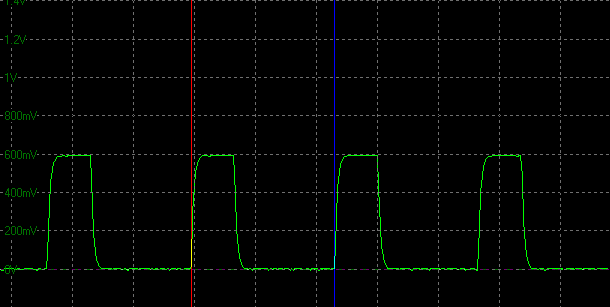
ULMB
backlight cycling, 85Hz
(scale = 5ms)
pulse width setting= 100
We measured the screen using our oscilloscope when
viewing a solid white image, with ULMB feature turned on and with
refresh rate set at 85Hz. This is the lowest refresh rate at which you can
operate the ULMB mode. As a reminder, it works at 85, 100 and 120Hz only. We
left the pulse width (strobe length) setting at 100 initially. Normally the oscillograph would show a flat straight
line when measuring a static white image (as no PWM is being used for backlight
dimming), but here the ULMB feature is cycling the backlight off and
on rapidly.
The time for each complete cycle is 11.76ms which
shows that in this case the backlight is being cycled at the same frequency as
the refresh rate, 85 times per second. The strobe is in time with the refresh
rate of 85Hz.
Operation - 100Hz
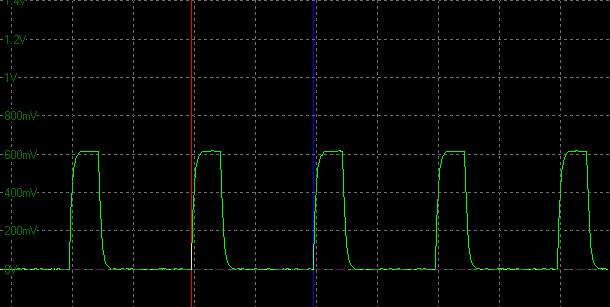
ULMB
backlight cycling, 100Hz
(scale = 5ms)
pulse width setting = 100
When running the screen at a 100Hz refresh rate
the behaviour is exactly the same. The only difference is that the strobe is now
synced with the new refresh rate, with a new strobe every 10ms (100 times per
second).
Operation - 120Hz
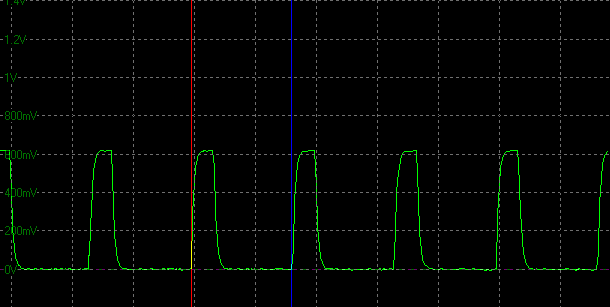
ULMB
backlight cycling, 120Hz
(scale = 5ms)
pulse width setting = 100
Again when set at 120Hz refresh rate the strobes
are in sync again, with a new strobe every 8.33ms (120 times per second). The
above is with pulse width at the default 100. We can also see what impact on the
strobing it has if you lower the pulse width setting.
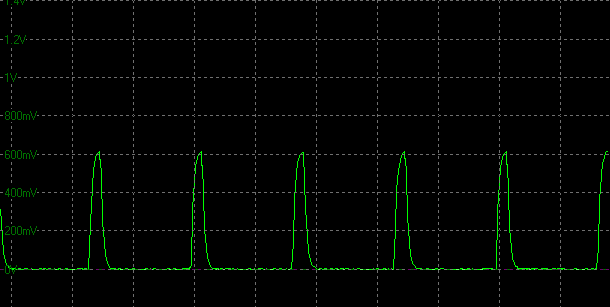
ULMB
backlight cycling, 120Hz
(scale = 5ms)
pulse width setting = 50
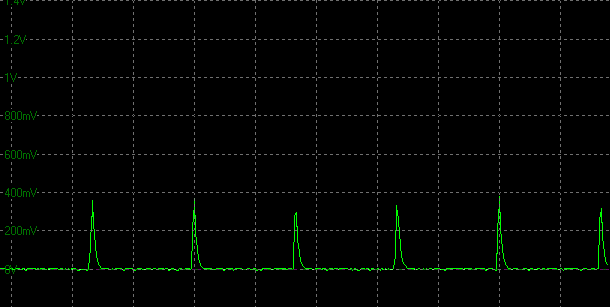
ULMB
backlight cycling, 120Hz
(scale = 5ms)
pulse width setting = 10
As you reduce the pulse width setting you are
adjusting the 'on' period of the strobe, shown by the top portion of each peak. As you reduce the setting the strobe
'on' time gets progressively shorter as you can see from the above 2 graphs, the
first at a setting of 50 and the second at a setting of 10 (the minimum setting
available). This impacts the perceived blur somewhat, with the shorter 'on'
times resulting in a clearer image. At the same time though the brightness of
the image is affected and it becomes very dark, the lower you go with the
setting. More on that in a moment. There will be a point where the user does not
see any further benefit to their eyes of reducing the strobe length further, but
you can have a play around with the setting to find your personal preference to
balance perceived motion blur and brightness of the image.
Pulse Width Setting - Strobe Length
We measured the strobe length at a variety of the
Pulse Width settings, while running at the maximum 120Hz refresh rate mode. You
can adjust the setting in steps of 1 incidentally. Each complete strobe lasts a
total of 8.33ms (120 strobes per second). This strobe timing was exactly the
same as we'd seen on other ULMB-enabled monitors at 120Hz including the
Asus ROG Swift PG278Q and
PG279Q for instance and so is likely fixed for the NVIDIA ULMB feature at
this refresh rate.
|
Pulse Width
Setting |
On period (ms) |
|
100 |
1.875 |
|
75 |
1.375 |
|
50 |
0.875 |
|
25 |
0.500 |
|
10 (min) |
0.250 |
Pulse Width Setting - Brightness Range (120Hz)
|
Pulse Width
Setting |
Luminance
(cd/m2) |
Black
Point (cd/m2) |
Contrast
Ratio
( x:1) |
|
100 |
118.02 |
0.14 |
831 |
|
75 |
81.85 |
0.10 |
818 |
|
50 |
55.07 |
0.07 |
787 |
|
25 |
27.79 |
0.03 |
926 |
|
10 (min) |
11.24 |
<0.02 |
- |
We tested the brightness output of the screen when
ULMB was turned on at 120Hz. You can independently control the brightness setting as well
if you want, but we left it at the default 100 and just changed the pulse width
(PW) strobe length setting to establish the brightness range when using this
option. With the PW setting at 100 the maximum achievable luminance of the
screen was a moderate 118
cd/m2. This
should be enough for a lot of uses, but you cannot get a brighter display when
using ULMB if you wanted to. This is a typical performance from a strobe
backlight anyway and represented a decent enough luminance level.
You can achieve a slightly brighter display if you
use the feature at 85 or 100Hz since the strobes are less frequent, but it's not
a significant amount.
As you reduce
the PW setting the luminance drops significantly, at the lowest setting probably
being far too dark for any practical use. At least you can control a reasonably
wide range here, so you can find a level which suits your needs. We suspect a
setting of 100 will probably be adequate for most normal users anyway, as the
ULMB mode certainly brings about positive improvements to the perceived motion
blur.
Brightness Range (PW at 100, 120Hz)
|
Brightness Setting |
Luminance
(cd/m2) |
Black
Point (cd/m2) |
Contrast
Ratio
( x:1) |
|
100 |
118.02 |
0.14 |
831 |
|
75 |
81.85 |
0.10 |
818 |
|
50 |
59.84 |
0.07 |
855 |
|
25 |
35.35 |
0.04 |
884 |
|
0 |
7.47 |
<0.02 |
- |
We also wanted to test the brightness range when
leaving PW at its default 100, and changing the brightness control of the screen
instead. This leaves the strobe behaviour alone, operating as it does with PW at
100, and instead just dims the backlight. The table above confirms the range available through that control.
You can achieve a slightly brighter display if you use the feature at 85 or
100Hz since the strobes are less frequent, but it's not a significant amount.
One annoying thing relating to the brightness
control became apparent as you switched ULMB on and off. When you first turn
ULMB on, the brightness level of the backlight remains as it was set before. So
while you might be using something around 28% brightness for a moderate desktop
brightness normally, when you turn ULMB you will almost certainly want to have
brightness at 100%. The brightness control is not separate for ULMB on/off
sadly. So you find yourself having to move the brightness control up to 100%
then. When you turn ULMB back off, the brightness setting stays at 100% in the
menu, but actually the brightness doesn't jump all the way up to the maximum
brightness level. It seems to level out at a random ~92
cd/m2 ish. When
you then change the brightness setting in the OSD menu, even by 1% down to 99%,
it jumps back to the "correct" brightness it would be normally. A bit of an odd
bug with the brightness level really when turning ULMB on and off.
Maximum Blur Reduction Brightness - Display
Comparison
For ease of reference we have
also provided a comparison table below of all the blur reduction enabled
displays we've tested, showing their maximum luminance before blur reduction is
turned on (normal mode) and their maximum luminance with the feature enabled.
This will give you an idea of the maximum brightness you can expect from each
model when using their blur reduction feature, if that is important to you. A
lot of people want a brighter display for gaming and sometimes the relatively
low maximum luminance from blur reduction modes is a limitation.
These comparisons are with the refresh rate as
high as is available for the blur reduction feature to function. For most this
is at 120Hz, but some also support the feature at higher. You can achieve a
slightly brighter display if you use the feature at 85 or 100Hz since the
strobes are less frequent, but it's not a significant amount. That can also
introduce more visible flicker in some situations.
|
Model |
Refresh Rate |
Max Normal Luminance
Blur Reduction Off
(cd/m2) |
Max Luminance
Blur Reduction On
(cd/m2) |
|
Acer XB270HU* |
100Hz* |
327 |
111 |
|
Asus ROG Swift PG278Q |
120Hz |
385 |
123 |
|
Asus ROG Swift PG279Q |
120Hz |
331 |
101 |
|
BenQ XL2720Z |
144Hz |
282 |
119 |
|
BenQ XL2730Z |
120Hz |
309 |
191 |
|
Dell S2716DG |
120Hz |
328 |
118 |
|
Eizo FG2421 |
120Hz |
386 |
257 |
Note:
Pulse Width setting at max where applicable.
*Note 2: The Acer XB270HU was later updated to include a 120Hz mode, which will produce a
slightly darker maximum luminance
Colour and Other Setup Characteristics
We wanted to test the impact on the setup of the
screen when enabling the ULMB feature to see whether it has a knock-on
effect to white point, gamma or colour accuracy. You can see straight away that
it impacts the luminance of the screen, which we've already looked at above.
|
Monitor OSD Option |
Default Settings |
|
Preset mode |
Standard |
|
Brightness |
26 |
|
Contrast |
75 |
|
RGB |
97, 99, 96 |

Dell S2716DG - Calibrated Settings, ULMB Off

|
|
Calibrated Settings |
|
luminance (cd/m2) |
119 |
|
Black Point (cd/m2) |
0.14 |
|
Contrast Ratio |
876:1 |
Above is our calibrated state from
earlier on
in the review, with the ULMB feature turned off.

Dell S2716DG - Calibrated Settings, ULMB On
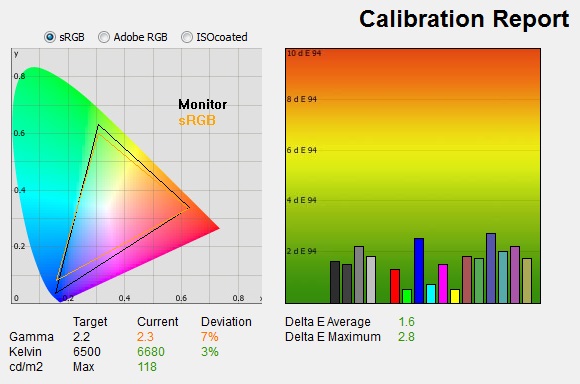
|
|
Calibrated Settings
ULMB On |
|
luminance (cd/m2) |
118 |
|
Black Point (cd/m2) |
0.14 |
|
Contrast Ratio |
831:1 |
We turned the ULMB mode on, but left the PW option
at 100 here, and with the default maximum 100 brightness as well. We left our
calibrated ICC profile active from our initial calibration to see what immediate
impact the ULMB setting had on the colour performance. The gamma and white point
were skewed slightly here, with gamma now a little higher at 2.3 average (7%
deviance), and white point being a little cooler at 6680k (3% out). The contrast
ratio remained similar at 831:1. The colour accuracy was also a little off with
average dE of 1.6 now, maximum of 2.88. No
major impact really to the appearance of the screen of the colour rendering
other than the reduction in achievable luminance of course. This was pleasing as
we know from testing older LightBoost strobed backlight systems that they can
really impact the colours and white point of a screen when enabled.
Blur Reduction Tests
Of course the main thing we want to test is what
improvements the Blur Reduction mode offers when it comes to motion clarity and
gaming. We were pleased with the results we'd seen from LightBoost backlights
when we tested them, and also from the natively supported blur reduction
feature on other displays including the other popular TN Film gaming models
we've tested.
We were very pleased with the results
here as we had been on other blur reduction displays, with an obvious and marked improvement in perceived motion blur experienced.
Tracking of moving objects became much easier and the image looked sharper and
clearer. We used the BlurBusters full-screen
TestUFO online motion test (all ULMB supported refresh rates) as well to put the
feature through its paces and were pleased with the results. The upper half of
the screen was a little clearer than the bottom, and in the bottom third of the
screen some strobe cross-talk became apparent. It is impossible to eliminate
strobe cross-talk completely due to the way they operate, but the important
thing is whereabouts on the screen this manifests itself and to what level. The
central region is probably the most important since that's where a lot of your
gaming focus will be, where crosshairs and the likes are. We were pleased that
there was minimal cross-talk here in the central region and the image looked
very good. Having the ability to alter the strobe length through the PW setting
was also very useful, and you could tweak it to your preference to reduce even
more
of the persistence if you wanted, as long as you didn't mind sacrificing some
brightness.
Another very good implementation of a strobe backlight
system here, we were impressed. We suppose the only minor quibble is the
inability to operate the feature at 144Hz or in an ideal World, at the same time
as using G-sync.

Additional Gaming Features
1) Preset modes
- There aren't any specific game preset modes on this model at all, so
you will probably need to change the main mode to your liking. It might have
been useful to have another preset mode available so you could have one set
up for gaming, and another for more general uses.
4) Aspect
Ratio Control - The S2716DG does not offer any
aspect ratio control options through the OSD menu at all. This is due to a
limitation of using NVIDIA's G-sync technology. As we understand it, it is
locked to only one defined resolution, in this case 2560 x 1440 so it is not
possible (or easy) to provide G-sync support with a scaler. This isn't really a
problem for PC use since you can just control the aspect ratio through your
graphics card settings. It would be an issue perhaps for external devices, but
since the screen is natively 16:9 it should be fine with most external devices
anyway (consoles, DVD players etc) which run in the same format. The absence
of a scaler is not a big issue here.

Lag
We have written an in depth article about
input lag and the various measurement techniques which are used to evaluate
this aspect of a display. It's important to first of all understand the
different methods available and also what this lag means to you as an end-user.
Input Lag vs. Display Lag vs. Signal
Processing
To avoid confusion with different terminology we
will refer to this section of our reviews as just "lag" from now on, as there
are a few different aspects to consider, and different interpretations of the
term "input lag". We will consider the following points here as much as
possible. The overall "display lag" is the first, that being the delay between
the image being shown on the TFT display and that being shown on a CRT. This is
what many people will know as input lag and originally was the measure made to
explain why the image is a little behind when using a CRT. The older stopwatch
based methods were the common way to measure this in the past, but through
advanced studies have been shown to be quite inaccurate. As a result, more
advanced tools like SMTT provide a method to measure that delay between a TFT
and CRT while removing the inaccuracies of older stopwatch methods.
In reality that lag / delay is caused by a
combination of two things - the signal processing delay caused by the TFT
electronics / scaler, and the response time of the pixels themselves. Most
"input lag" measurements over the years have always been based on the overall
display lag (signal processing + response time) and indeed the SMTT tool is
based on this visual difference between a CRT and TFT and so measures the
overall display lag. In practice the signal processing is the element which
gives the feel of lag to the user, and the response time of course can
impact blurring, and overall image quality in moving scenes. As people become
more aware of lag as a possible issue, we are of course keen to try and
understand the split between the two as much as possible to give a complete
picture.
The signal processing element within that is quite
hard to identify without extremely high end equipment and very complicated
methods. In fact the studies by Thomas Thiemann which really kicked this whole
thing off were based on equipment worth >100,1000 Euro, requiring extremely high
bandwidths and very complicated methods to trigger the correct behaviour and
accurately measure the signal processing on its own. Other techniques which are
being used since are not conducted by Thomas (he is a freelance writer) or based
on this equipment or technique, and may also be subject to other errors or
inaccuracies based on our conversations with him since. It's very hard as a
result to produce a technique which will measure just the signal processing on
its own unfortunately. Many measurement techniques are also not explained and so
it is important to try and get a picture from various sources if possible to
make an informed judgement about a display overall.
For our tests we will continue to use the SMTT
tool to measure the overall "display lag". From there we can use our
oscilloscope system to measure the response time across a wide range of grey to
grey (G2G) transitions as recorded in our
response time
tests. Since SMTT will not include the full response time within its
measurements, after speaking with Thomas further about the situation we will
subtract half of the average G2G response time from the total display lag. This should allow us to give a good estimation of
how much of the overall lag is attributable to the signal processing element on
its own.
Lag Classification
To help in this section we will also introduce a broader classification system
for these results to help categorise each screen as one of the following levels:
-
Class 1)
Less than 16ms / 1 frame lag at 60Hz - should be fine for gamers, even at high levels
-
Class
2)
A lag of 16 -
32ms / One to two frames of lag at 60Hz - moderate lag but should be fine for many gamers.
Caution advised for serious gaming and FPS
-
Class
3)
A lag of more
than 32ms / more than 2 frames of lag at 60Hz - Some noticeable lag in daily usage, not
suitable for high end gaming
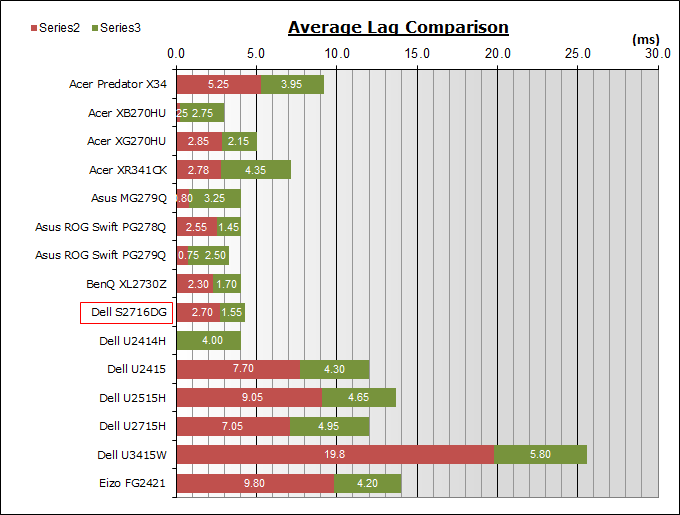
For the full reviews of the models compared here and the dates they were written
(and when screens were approximately released to the market), please see our
full
reviews index.
|
(Measurements in ms) |
|
|
Total Display Lag (SMTT
2) |
4.25 |
|
Pixel Response Time
Element |
1.55 |
|
Estimated Signal
Processing Lag |
2.70 |
|
Lag Classification |
1 |
|

Class 1 |
We have provided a comparison above against other
models we have tested to give an indication between screens. The screens
tested are split into two measurements which are
based on our overall display lag tests (using SMTT) and half the average G2G
response time, as measured by the oscilloscope. The response time is split from
the overall display lag and shown on the graph as the green bar. From there, the
signal processing (red bar) can be provided as a good estimation.
The screen showed a total lag of only 4.25ms.
Approximately 1.55ms of that can be accounted for by pixel response times,
leaving an estimated signal processing lag of only 2.7ms. This is basically
nothing and means the screen should be fine for all levels of gaming. Other
G-sync screens to date have shown similar very low levels of lag which is
pleasing. This remains consistent at all refresh rates, and also when using
ULMB.

Movies and Video

The following summarises the screens performance
in video applications:
-
27"
screen size makes it a reasonable option for an all-in-one multimedia screen,
much smaller than LCD TV's and many larger format desktop monitors which are
now emerging.
-
16:9
aspect ratio is well suited to videos and movies, leaving
you with smaller/no borders on DVD's and wide screen content at the top and
bottom than on a 16:10 aspect display.
-
2560 x
1440 resolution can support full 1080 HD resolution content.
-
Digital DisplayPort interfaces support HDCP for any encrypted and protected content
-
DisplayPort and HDMI connections available
which is an improvement over older G-sync screens. The addition of HDMI is
certainly welcome for connecting external devices and Blu-ray players.
-
Cable provided in the box
for DisplayPort only.
-
Moderate AG coating provides reasonably clear images with no major graininess,
and without the unwanted reflections of a glossy solution. Some graininess
apparent as with other TN Film panels, but shouldn't present a problem in
movies.
-
Wide
brightness range adjustment possible from the display, including high maximum
luminance of ~328
cd/m2 and a good minimum luminance of
38 cd/m2. This should afford you very good control for different
lighting conditions. Contrast ratio remains stable across the adjustment
range as well and is good for a TN Film panel. Brightness regulation is controlled
without the need for PWM and so is flicker free at all settings which is
pleasing.
-
Black
depth and contrast ratio are good for an TN Film panel at 876:1 after
calibration. Detail in darker scenes should not be lost as a result.
-
There
is no specific 'movie' preset mode available sadly only the standard mode
which you might have to keep changing for differing uses perhaps.
-
Very
good pixel responsiveness which can handle fast moving scenes in movies
without issue. Low to moderate overshoot issues when sticking to the 'normal'
response time mode which is good.
-
Although it has 120Hz+
refresh rate support it does not support NVIDIA 3D Vision.
-
Viewing angles are limited due to the use of TN Film panel technology. May
cause issues with gamma and contrast shift if you change your line of sight or
have several people trying to see the screen at once. Not really an ideal
technology for movies as a result of this viewing angle limitation.
-
No
real backlight leakage on our sample which is good.
-
Wide range of ergonomic adjustments available
from the stand, allowing you to adjust the screen to suit varying viewing
positions.
-
No
integrated stereo speakers offered on this model but there is an audio out and
headphone connection.
-
No
hardware aspect ratio options on this screen, but graphics card can handle the
scaling if using a PC. For external devices the native 16:9 format should mean
most things aren't too much of an issue anyway.
-
Picture By Picture (PbP) or Picture In Picture (PiP) are not available on
this model.

Conclusion
If you enjoy the review and like our work, we
would welcome a
donation
to the site to help us continue to make quality and detailed reviews for you.
It was really good to see a new gaming-focused
screen from Dell, a manufacturer who have been known for producing quality
displays and offering excellent support and warranties over the years. They've
branched out from their more mainstream and multimedia displays, and their first
proper venture in to the gaming arena has been a success we think. We liked the
design of the new model, with a very thin bezel design, sleek appearance and
quality build. The stand is also very good and the connectivity was adequate
(limited by G-sync), with a few nice extras like the USB ports and audio
connections.
Performance-wise the main area of interest is in
gaming performance, and it doesn't fail to deliver here. The response times are
very fast and it's certainly on par with other very popular TN Film gaming
options from the like of Asus, Acer and BenQ. The 144Hz refresh rate is
obviously a huge benefit, and the combination with NVIDIA G-sync makes the whole
experience even better. That's particularly important when you consider the
boosted resolution here and the demand that will have on your graphics card. The
higher resolution is a benefit in itself especially when you look outside of
gaming applications. We were also pleased to see ULMB included here which
brought about the usual excellent benefits when it comes to blur reduction. The
lag was also non-existent, in line with other G-sync models we've tested. The
only real negative when it came to gaming was the weird brightness control when
switching ULMB on and off that we've talked about in the review.
Away from gaming the screen fell a bit short we
felt in some areas. The default setup was aimed at gaming, but left us with a
low gamma for other day to day uses, and difficulty changing that without a
calibration device. We would have also liked to see some preset modes offered so
we could set one up for general use and another for gaming. The screen was also
limited by the TN Film technology in some areas, particularly viewing angles but
that is the same as other TN Film models around and should be a known sacrifice
really. Overall it's a very solid gaming screen and provides an interesting
alternative to the lesser-established brands out there if you want something
from a long-standing, proven manufacturer.
|
Pros |
Cons |
|
Excellent gaming performance
with high refresh rate, fast response times, non-existent lag, G-sync and
ULMB |
Default setup aimed at gaming
and not as good for general uses |
|
Nice design and ultra-thin
bezel |
Limitations of TN Film
technology when it comes to viewing angles particularly |
|
Flicker free backlight |
Annoying brightness control
when switching ULMB on/off |
|
Check Pricing and Buy - Direct Links
|
|
Amazon USA |
Amazon
UK |
Amazon GER |
Amazon CAN
|
|
TFTCentral is a participant
in the Amazon Services LLC Associates Programme, an affiliate
advertising programme designed to provide a means for sites to earn
advertising fees by advertising and linking to Amazon.com, Amazon.co.uk,
Amazon.de, Amazon.ca and other Amazon stores worldwide. We also
participate in a similar scheme for Overclockers.co.uk. |
|
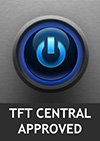
|
TFT Central Awards Explained
We have two award
classifications as part of our reviews. There's the top 'Recommended'
award, where a monitor is excellent and highly recommended by us. There is
also an 'Approved' award for a very good screen which may not be perfect,
but is still a very good display. These awards won't be given out every
time, but look out for the logo at the bottom of the conclusion. A list of
monitors which have won our awards is available
here. |